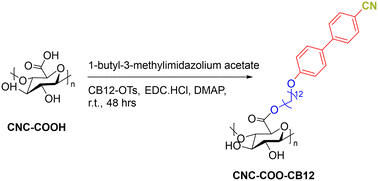Self-assembled materials from cellulose nanocrystals conjugated with a thermotropic liquid crystalline moiety†
Abstract
Manipulating molecular and supramolecular interactions within cellulose nanocrystals (CNCs) to introduce different levels of assemblies combined with multiple functionalities is required for the development of degradable smart materials from renewable resources. To attain hierarchical structures and stimuli-responsive properties, a new class of liquid crystalline cellulosic hybrid materials is synthesized. Herein, main-chain rigid-rod-like oxidized cellulose (CNC–COOH) is prepared from a Cellulose Whatman filter paper (Cellulose W.P.) by acid hydrolysis and oxidized using 2,2,6,6-tetramethyl-1-piperidinyloxy (TEMPO). Thermotropic LC molecule, 4-cyano-4'-hydroxybiphenyl with a 12-methylene spacer (CB12–OH) is grafted onto the carboxylic acid group of CNC–COOH via Steglich esterification. The liquid crystalline functionalized CNCs cellulose nanocrystals (CNC–COO–CB12) are readily soluble in DMSO and ionic liquids. The extent of functionalization and structure of CNC–COO–CB12 are confirmed by solution-state 1H NMR and supported by other characterization techniques. We investigate the interplay of liquid crystalline orientational order of CNCs and cyanobiphenyl (CB12), and the supramolecular hydrogen bonding of CNCs within CNC–COO–CB12 and compare it with CNC–COOH. The introduction of thermotropic CB12 side chains onto rigid-rod CNCs shows the exclusive formation of smectic mesophases from the assemblies of CB12 with the absence of the cholesteric mesophase typically observed from CNC–COOH as verified by temperature-controlled SAXS (T-SAXS). This is further verified by UV-visible and SEM studies that show CNC–COO–CB12 forms smectic domains while CNC–COOH forms a visible light reflecting cholesteric mesophase in dried films. Thus, the interplay of liquid crystalline order of CNCs and CB12 and supramolecular hydrogen bonding of CNCs results in ordered, smectic-mesostructured CNCs for use in stimuli-responsive functional materials.



 Please wait while we load your content...
Please wait while we load your content...
